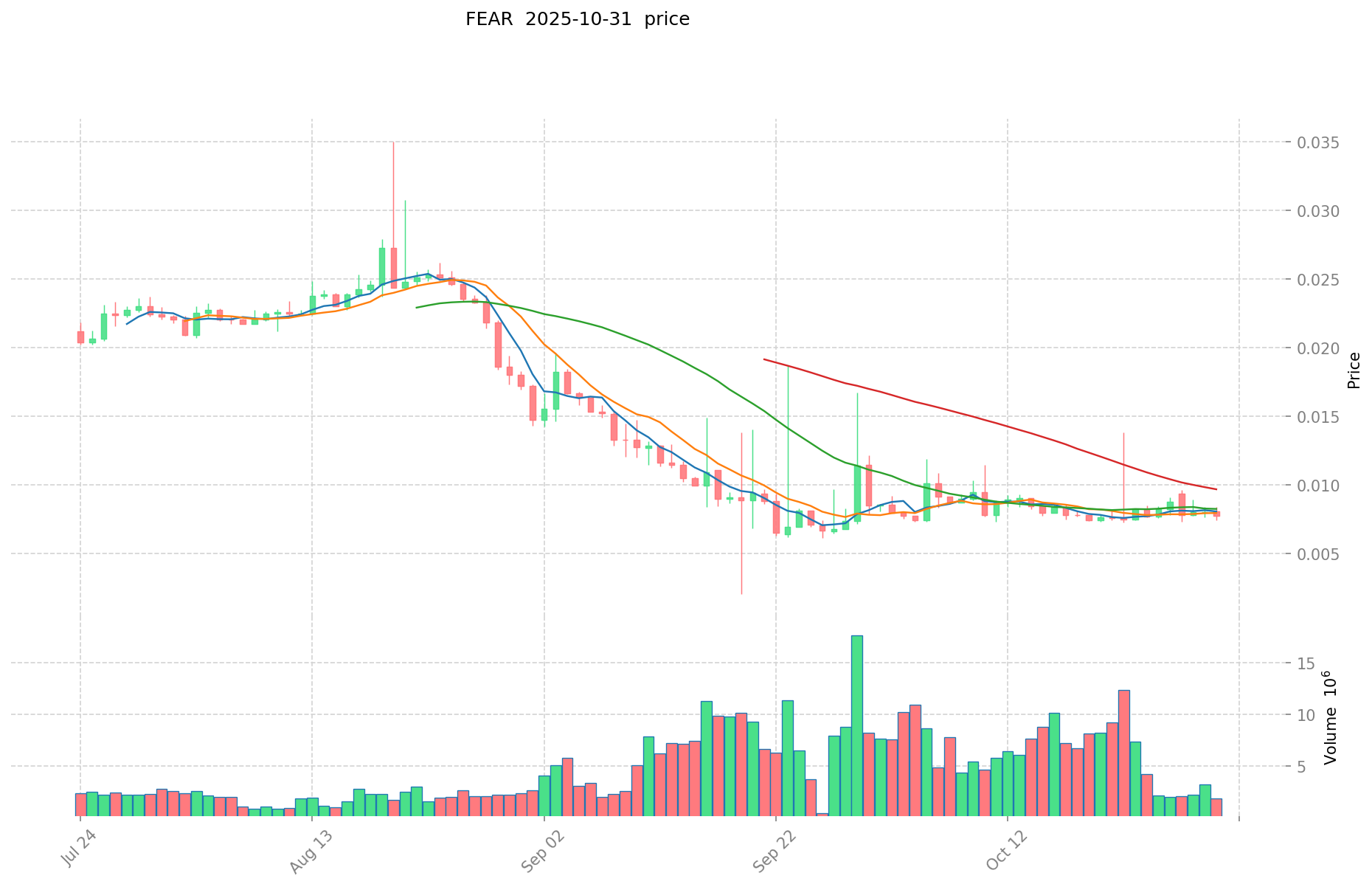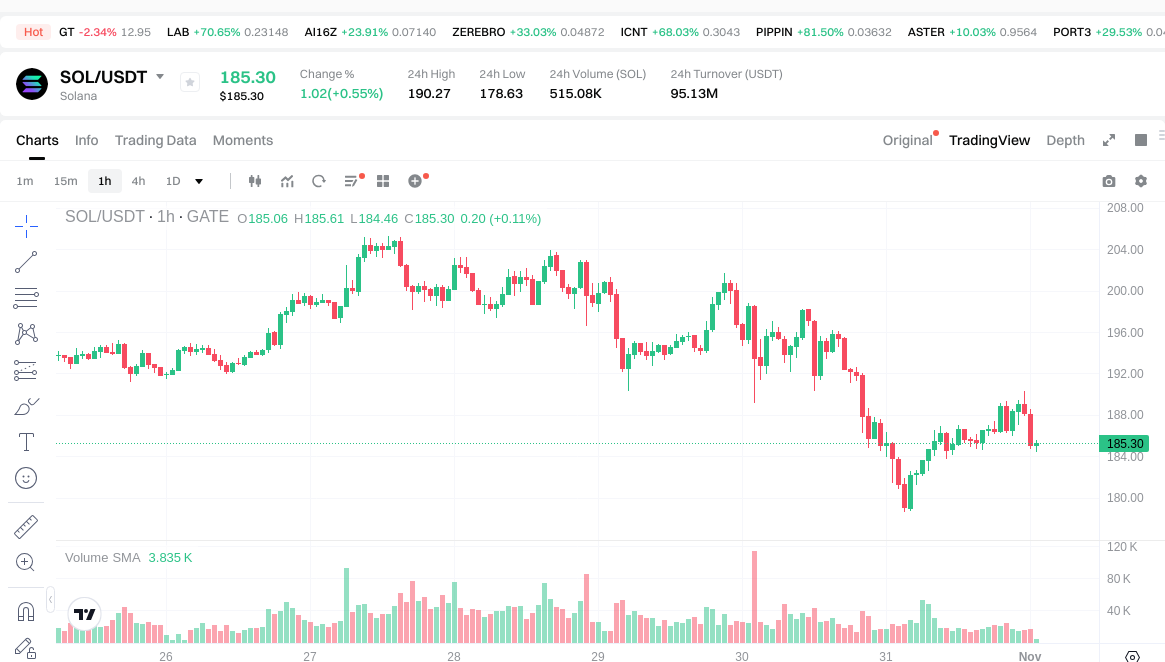FEAR vs SOL: The Battle Between Emotional Instinct and Rational Decision-Making in Cryptocurrency Investing
Introduction: Investment Comparison between FEAR and SOL
In the cryptocurrency market, the comparison between FEAR vs SOL has always been a topic that investors cannot avoid. The two not only show significant differences in market cap ranking, application scenarios, and price performance, but also represent different positioning of crypto assets.
FEAR (FEAR): Since its launch in 2021, it has gained market recognition as a mixed NFT token and blockchain game horror brand.
Solana (SOL): Introduced in 2020, it has been hailed as a high-performance blockchain protocol designed for scalability, earning its place as one of the cryptocurrencies with the highest global trading volume and market capitalization.
This article will comprehensively analyze the investment value comparison between FEAR vs SOL, focusing on historical price trends, supply mechanisms, institutional adoption, technological ecosystems, and future predictions, attempting to answer the question investors are most concerned about:
"Which is the better buy right now?"
I. Price History Comparison and Current Market Status
FEAR and SOL Historical Price Trends
- 2021: FEAR reached its all-time high of $3.88 due to the overall cryptocurrency market bull run.
- 2023: SOL experienced significant growth, benefiting from increased adoption and ecosystem expansion.
- Comparative analysis: During the 2022 bear market, FEAR dropped from its peak to near its all-time low, while SOL showed more resilience and recovered faster in 2023.
Current Market Situation (2025-11-01)
- FEAR current price: $0.008097
- SOL current price: $185.25
- 24-hour trading volume: FEAR $9,810.54 vs SOL $95,080,695.11
- Market Sentiment Index (Fear & Greed Index): 29 (Fear)
Click to view real-time prices:
- Check FEAR current price Market Price
- Check SOL current price Market Price


The Core Factors Influencing Investment Value of FEAR vs SOL
I. Understanding Solana's Investment Value
Technical Foundation: Speed and Cost Efficiency
- High transaction processing capacity: Up to 65,000 TPS
- Minimal transaction fees: Average of $0.00025 per transaction
- Innovative consensus mechanism: Proof of History (PoH) combined with Proof of Stake (PoS)
- Modular design allowing horizontal scaling to prevent network congestion
Ecosystem Growth and Applications
- DeFi ecosystem: TVL increased from under $1 billion in early 2023 to over $4 billion in 2024
- NFT marketplace expansion: Platforms like Magic Eden and Tensor becoming user preferences
- Meme coin phenomenon: BONK and WIF tokens driving retail investor interest
- Gaming and AI applications: Star Atlas and Render Network integration
Institutional Interest and Market Factors
- Traditional financial giants: BlackRock launching tokenized assets on Solana in 2024
- ETF speculation: Despite not materializing, generated significant market interest
- Market dynamics: SOL performing as a high beta asset during bull markets
- Search trends: High user interest in "Solana future price predictions"
II. Key Factors Affecting Investment Value of FEAR vs SOL
Technical Development and Ecosystem Building
- SOL technical development: Firedancer upgrade in 2023 improved network stability and decentralization
- SOL ecosystem comparison: Strong presence in DeFi (Serum, Raydium), NFTs (Magic Eden), and meme coins
- Ecosystem metrics: SOL's active developer community and regular hackathons create network effects
- Corporate partnerships: Google Cloud and Visa supporting Solana with new application scenarios
Institutional Adoption and Market Applications
- Institutional holdings: SOL has attracted traditional financial giants like BlackRock
- Market applications: SOL widely used for DeFi protocols, requiring SOL for staking or transaction fuel
- Regulatory attitudes: SEC discussions about SOL's security status influence investor sentiment
- Partnership ecosystem: SOL's partnerships with major companies provide additional use cases
Macroeconomic and Market Cycles
- Performance in inflationary environment: SOL as a high-beta asset shows volatility above market average
- Macro monetary policy: Bitcoin halving events and Federal Reserve interest rate expectations affect SOL
- Crypto market cycles: SOL shows resilience even during bear markets (2022) due to community loyalty
- Market sentiment: Community-driven activities create positive feedback loops for SOL
Risk Assessment
- Network reliability: SOL has experienced past network outages
- Centralization concerns: Some critics point to SOL's centralized aspects
- External dependencies: SOL was impacted by the FTX collapse
- Investment considerations: Diversification recommended due to cryptocurrency volatility
III. 2025-2030 Price Prediction: FEAR vs SOL
Short-term Prediction (2025)
- FEAR: Conservative $0.00574887 - $0.008097 | Optimistic $0.008097 - $0.00858282
- SOL: Conservative $122.43 - $185.5 | Optimistic $185.5 - $272.685
Mid-term Prediction (2027)
- FEAR may enter a growth phase, with expected prices ranging from $0.007337452818 to $0.012641635578
- SOL may enter a bull market, with expected prices ranging from $208.840723 to $335.116509
- Key drivers: Institutional capital inflow, ETFs, ecosystem development
Long-term Prediction (2030)
- FEAR: Base scenario $0.014135116637124 - $0.016679437631806 | Optimistic scenario $0.016679437631806+
- SOL: Base scenario $417.644413197375 - $471.93818691303375 | Optimistic scenario $471.93818691303375+
Disclaimer
FEAR:
| 年份 | 预测最高价 | 预测平均价格 | 预测最低价 | 涨跌幅 |
|---|---|---|---|---|
| 2025 | 0.00858282 | 0.008097 | 0.00574887 | 0 |
| 2026 | 0.0093406992 | 0.00833991 | 0.005837937 | 3 |
| 2027 | 0.012641635578 | 0.0088403046 | 0.007337452818 | 9 |
| 2028 | 0.01450030962015 | 0.010740970089 | 0.00590753354895 | 32 |
| 2029 | 0.015649593419673 | 0.012620639854575 | 0.008834447898202 | 55 |
| 2030 | 0.016679437631806 | 0.014135116637124 | 0.00918782581413 | 74 |
SOL:
| 年份 | 预测最高价 | 预测平均价格 | 预测最低价 | 涨跌幅 |
|---|---|---|---|---|
| 2025 | 272.685 | 185.5 | 122.43 | 0 |
| 2026 | 256.5836 | 229.0925 | 167.237525 | 23 |
| 2027 | 335.116509 | 242.83805 | 208.840723 | 31 |
| 2028 | 421.90682807 | 288.9772795 | 277.41818832 | 55 |
| 2029 | 479.84677260975 | 355.442053785 | 231.03733496025 | 91 |
| 2030 | 471.93818691303375 | 417.644413197375 | 242.2337596544775 | 125 |
IV. Investment Strategy Comparison: FEAR vs SOL
Long-term vs Short-term Investment Strategies
- FEAR: Suitable for investors focused on niche gaming and NFT sectors
- SOL: Suitable for investors seeking ecosystem growth and institutional adoption
Risk Management and Asset Allocation
- Conservative investors: FEAR: 5% vs SOL: 15%
- Aggressive investors: FEAR: 10% vs SOL: 30%
- Hedging tools: Stablecoin allocation, options, cross-currency portfolios
V. Potential Risk Comparison
Market Risk
- FEAR: Limited liquidity and high volatility
- SOL: Susceptible to broader crypto market trends and macroeconomic factors
Technical Risk
- FEAR: Limited ecosystem development, network scalability concerns
- SOL: Network outages, centralization concerns
Regulatory Risk
- Global regulatory policies may impact both, with SOL potentially facing more scrutiny due to its larger market presence
VI. Conclusion: Which Is the Better Buy?
📌 Investment Value Summary:
- FEAR advantages: Niche market in gaming and NFTs, potential for growth in specific use cases
- SOL advantages: Strong ecosystem, institutional interest, high performance, and scalability
✅ Investment Advice:
- Novice investors: Consider SOL for its established ecosystem and broader market recognition
- Experienced investors: Diversify with both, allocating more to SOL but including FEAR for potential high-risk, high-reward opportunities
- Institutional investors: Focus on SOL due to its liquidity, ecosystem depth, and potential for mainstream adoption
⚠️ Risk Warning: The cryptocurrency market is highly volatile. This article does not constitute investment advice. None
VII. FAQ
Q1: What are the main differences between FEAR and SOL? A: FEAR is a niche token focused on gaming and NFTs, while SOL is a high-performance blockchain protocol with a broad ecosystem. SOL has higher market capitalization, trading volume, and institutional adoption compared to FEAR.
Q2: How do the price predictions for FEAR and SOL compare for 2030? A: By 2030, FEAR is predicted to reach a base scenario of $0.014135116637124 - $0.016679437631806, while SOL's base scenario is $417.644413197375 - $471.93818691303375. SOL is expected to have a higher potential for growth.
Q3: What are the main risks associated with investing in FEAR and SOL? A: FEAR faces risks of limited liquidity and ecosystem development. SOL's main risks include potential network outages, centralization concerns, and regulatory scrutiny due to its larger market presence.
Q4: How do institutional investors view FEAR vs SOL? A: Institutional investors tend to favor SOL due to its established ecosystem, liquidity, and potential for mainstream adoption. FEAR has less institutional interest due to its niche focus and smaller market cap.
Q5: What factors contribute to SOL's ecosystem growth? A: SOL's ecosystem growth is driven by its DeFi applications, NFT marketplaces, meme coins, gaming platforms, and partnerships with major companies like Google Cloud and Visa. Its high transaction speed and low fees also attract developers and users.
Q6: How do macroeconomic factors affect FEAR and SOL? A: Both are influenced by overall crypto market trends, but SOL is more sensitive to macroeconomic factors like inflation, interest rates, and institutional investment flows due to its larger market presence and higher trading volume.
Q7: What investment strategies are recommended for FEAR vs SOL? A: For conservative investors, a smaller allocation to FEAR (around 5%) and a larger allocation to SOL (around 15%) is suggested. Aggressive investors might consider 10% for FEAR and 30% for SOL. It's important to diversify and consider individual risk tolerance.
Share
Content